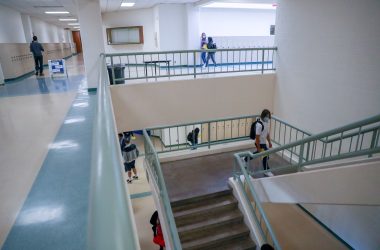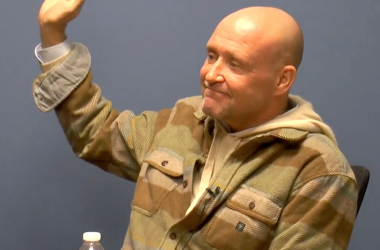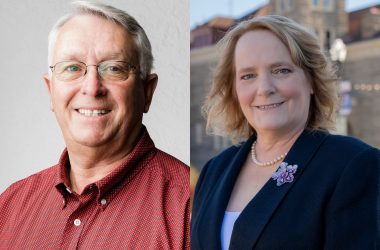
A United Way visitor tours a demonstration tiny home in the organization’s parking lot on July 17, 2019 (Rachel Alexander/Salem Reporter)
Ron Hays, chief executive officer of United Way of the Mid-Willamette Valley, has had a phrase follow him through his career: “Affordable housing can’t be built affordably.”
About a year ago, he decided to take it as a challenge.
What began as a math problem sketched out on white boards Hays’ office is now a fully built 300-square-foot tiny house sitting in the United Way parking lot.
It’s intended as a rental for someone living entirely off Social Security benefits, earning about $1,000 a month.
In the Salem area, United Way would like to build 1,000 units over the next decade, said Andrew Galen, director of strategic initiatives. But they plan to start small: a proof-of-concept village of about 25 tiny homes on one acre.
“It’s really about finding the right piece of property,” Galen said.
Keep local news going – subscribe to Salem Reporter.
A growing number of seniors are facing homelessness because they can no longer afford rising rents, said Ashley Hamilton, program director of the ARCHES Project, the Salem area’s main homeless services provider.
“They’ve been in a particular unit a long time and are now seeing price increases above their monthly income,” Hamilton said.
Federal housing programs consider someone “rent-burdened” if they spend more than 30 percent of their income on rent.
For United Way’s target renter, that would mean paying no more than about $350 a month.
“There’s no place that cheap out there,” Hays said.

Ron Hays, CEO of United Way of the Mid-Willamette Valley, visits a tiny home under construction at 20 Twenty in Salem (Rachel Alexander/Salem Reporter)
Traditionally, affordable housing programs make up the difference with rental subsidies, usually through federal programs. But wait lists can be years long, and the need far exceeds the number available.
Hays said he’s become convinced subsidies alone cannot solve the problems of homelessness or affordable housing. So the United Way team worked backwards: For a monthly $350 payment, what could they build and finance through a traditional mortgage?
The answer is a manufactured, 300-sqaure-foot home built by Salem company 20 Twenty. It’s equipped with a mini-fridge, two-burner stove, washer and dryer, shower, sink and toilet, with handles on the bathroom wall and wider doors to accommodate wheelchairs.
Hays has worked with the company to keep manufacturing costs down and expects United Way can buy a house and the land underneath for $70,000 or less.
The walls are made from super-insulated concrete panels that are a cheaper alternative, company president Joseph Babcock said.
The company mostly does worker housing, building small units in North Dakota’s Bakken oilfields. The United Way project will be their first with a nonprofit.

The model United Way tiny home includes a combined washer and dryer and a full bathroom with a small storage closet. (Rachel Alexander/Salem Reporter)
The idea of solving homelessness with tiny homes is not new. Seattle has embraced small villages of tiny homes to house a skyrocketing population of homeless people. But those villages are constructed with support from the city, and homes sometimes lack plumbing or other amenities, making them more suitable as an alternative to emergency shelters, rather than a permanent home.
In Eugene, nonprofit Square One Villages has found success with communities of tiny homes governed by residents. Their tenants are mostly people who struggled to afford housing but don’t need intensive help, like mental health or addiction treatment, executive director Dan Bryant said. The bulk of their applicants were at least 60, he said.
Rent is between $250 and $350 a month and include utilities. Residents do maintenance work around the village to keep costs low and build up an equity share of $1,500 in the home, which they can sell if they decide to move.
They fundraised with private entities like churches to build homes in advance rather than take on debt, Bryant said.
Like United Way, Bryant said they approached the problem by looking at a typical disability payment – about $780 a month – and working backwards.
“I see a lot of people on the street who have disability income, but it’s not enough to live on,” he said.
That search is underway, though United Way hasn’t yet identified a site.
Hays said they hope to break ground on an initial village by the end of the year.
Hamilton said she’s excited by the effort, which she hopes will provide stability to seniors who often struggle with chronic health problems made worse by not having permanent housing.
“It’s absolutely fantastic,” she said. “They don’t have to worry about homelessness – they can focus on maintaining their health.”
Reporter Rachel Alexander: (503) 575-1241 or [email protected]

Rachel Alexander is Salem Reporter’s managing editor. She joined Salem Reporter when it was founded in 2018 and covers city news, education, nonprofits and a little bit of everything else. She’s been a journalist in Oregon and Washington for a decade. Outside of work, she’s a skater and board member with Salem’s Cherry City Roller Derby and can often be found with her nose buried in a book.









